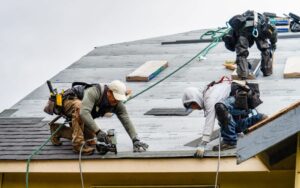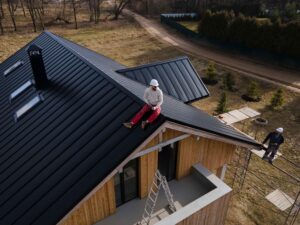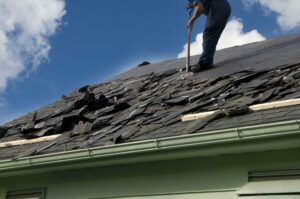When it comes to replacing your roof, cost is a significant factor. You’ll want to evaluate various elements, such as materials and labor, to find the most affordable option. Choosing the right roofing material can impact both your budget and the roof’s longevity. Additionally, whether you decide to tackle the project yourself or hire a contractor can drastically change costs. Let’s explore these aspects to find the most economical solution for your roof replacement.
Factors That Influence Roof Replacement Costs
When considering a roof replacement, several factors greatly influence the overall costs you’ll encounter. The size and type of your roof play critical roles; larger roofs require more materials and labor, while different materials can affect both complexity and duration of the job. The roof pitch is another factor; steeper roofs can increase safety measures and work difficulty, possibly raising costs. Accessibility also matters—hard-to-reach roofs may incur additional setup expenses. Additionally, the complexity of your roof, including any unique features, can require specialized expertise, potentially increasing the inspection and replacement costs. Understanding these elements helps you prepare for the financial commitment involved in replacing your roof efficiently.
Affordable Roofing Materials and Their Lifespan
After understanding the factors that influence roof replacement costs, it’s important to contemplate the materials you’ll use. Asphalt shingles are among the most affordable options, with a lifespan of 20 to 30 years. If you’re seeking durability, metal roofing, while pricier upfront, can last 40 to 70 years, offering long-term savings. For those on a tight budget, rolled roofing is a cost-effective choice, lasting around 10 to 15 years. Consider also composite shingles, which provide a balance between cost and longevity, lasting up to 50 years. Each material’s initial cost and lifespan should guide your decision, ensuring you choose an option that suits your budget and long-term needs effectively.
DIY vs. Professional Roof Replacement
If you’re considering a roof replacement, you’ll quickly realize that choosing between a DIY approach and hiring professionals can greatly affect both your budget and the quality of the outcome. DIY can save money upfront, but it demands significant time, skill, and access to tools. You might encounter hidden issues during the process, leading to unexpected costs. On the other hand, professional roofers offer expertise and efficiency, ensuring the job meets safety standards and building codes. They can spot potential problems early, which can prevent costly repairs later. Weigh the pros and cons carefully; while DIY may seem cheaper, professional services often provide long-term value and peace of mind that your roof is durable and well-installed.
Ways to Save on Roof Replacement Costs
Saving on roof replacement costs requires a strategic approach, especially since this considerable investment can strain your budget. Start by scheduling a thorough roof inspection, which typically costs between $120 and $600. This helps identify issues early, preventing costly repairs later. Opt for a basic visual inspection to save money, or consider advanced methods like drone inspections for hard-to-reach areas, which can provide detailed insights. Additionally, compare quotes from trusted local contractors, as prices can vary greatly. You might also explore timing your replacement during off-peak seasons to secure better rates. Finally, consider financing options or government incentives that can ease the financial burden, enabling you to make informed decisions without overspending.
Additional Tips for Reducing Roof Replacement Expenses
When it comes to reducing roof replacement expenses, exploring various cost-saving strategies can make a significant difference. Start by conducting regular roof inspections; identifying issues early can prevent costly repairs down the line. Opt for a basic visual inspection, typically ranging from $120 to $250, to assess visible damage. Consider scheduling inspections during off-peak seasons to save on service costs. When choosing materials, prioritize durability and energy efficiency, as they can reduce long-term expenses. Additionally, involving trusted local contractors can provide competitive pricing. Finally, inquire about warranties and follow-up services after repairs to guarantee ongoing savings and protection for your investment. Implementing these strategies will help you manage your roof replacement costs effectively.
Understanding the Hidden Costs of Roof Replacement
Understanding the hidden costs of roof replacement is essential for effective budgeting and planning. Beyond the visible expenses like materials and labor, consider factors like roof complexity and slope, which can inflate costs considerably. Measuring your roof’s square footage accurately is critical, as underestimating can lead to surprise expenses. Additionally, the choice of materials impacts not only initial costs but also future maintenance and longevity. Don’t overlook potential costs for safety equipment and scaffolding, particularly on steeper roofs. Finally, timing your replacement can influence pricing; spring often brings better rates and contractor availability. By grasping these hidden costs, you can make informed decisions and avoid financial surprises during your roof replacement project.
Frequently Asked Questions
What Are the Signs I Need a Roof Replacement?
You’ll need a roof replacement if you notice missing shingles, significant leaks, sagging areas, or extensive granule loss. Additionally, check for mold growth and sunlight streaming through the roof, indicating serious structural issues.
How Long Does a Roof Replacement Typically Take?
A roof replacement typically takes one to three days, depending on the size and complexity of your roof. Weather conditions can also impact the timeline, so it’s wise to consult your contractor for specific estimates.
Can I Finance My Roof Replacement?
Yes, you can finance your roof replacement. Many roofing companies offer financing options, allowing you to manage costs effectively. Research available plans, compare interest rates, and choose a solution that fits your budget and needs.
What Permits Are Required for Roof Replacement?
Before starting your roof replacement, check local regulations. You’ll likely need a building permit, and sometimes a zoning permit, depending on your area. Always confirm with your local government to verify compliance with all requirements.
Will My Homeowner’s Insurance Cover Roof Replacement Costs?
Your homeowner’s insurance might cover roof replacement costs if damage results from covered perils like storms. Review your policy details and contact your insurer for specific coverage information and claim procedures relevant to your situation.




